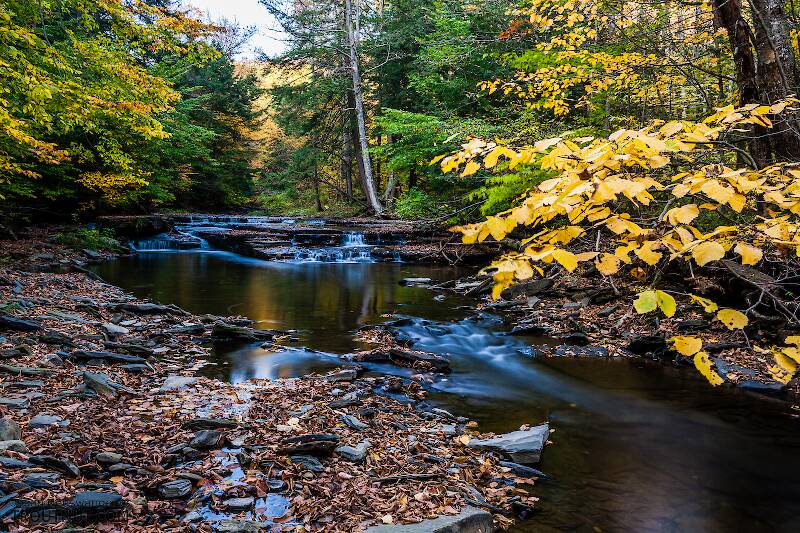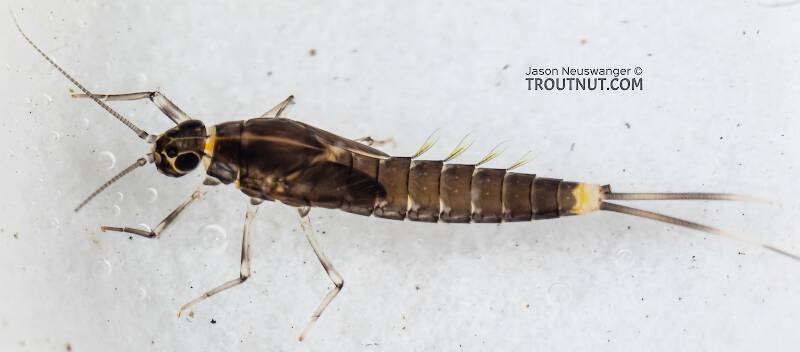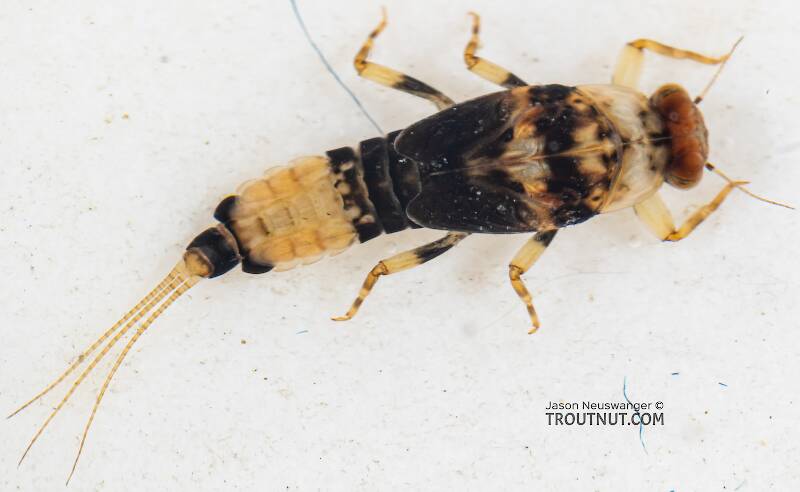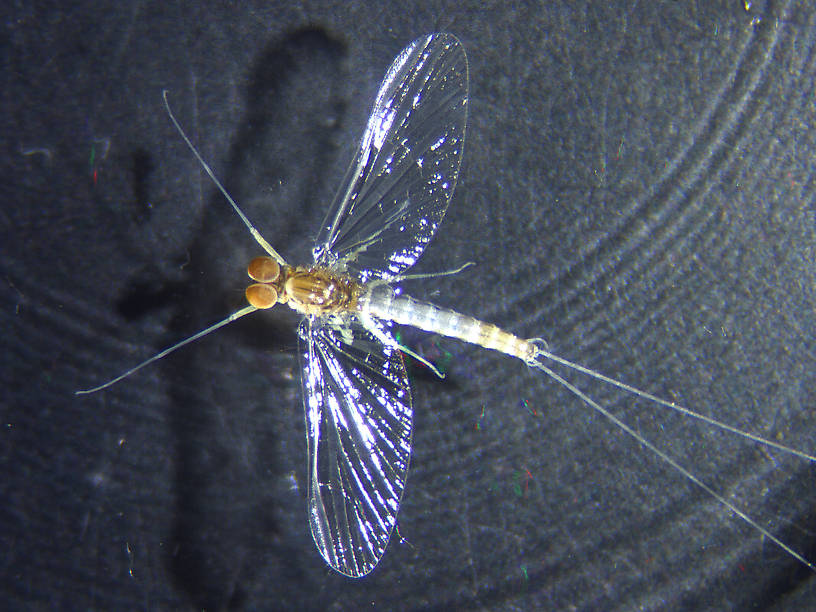
Hex Mayflies
Hexagenia limbata
The famous nocturnal Hex hatch of the Midwest (and a few other lucky locations) stirs to the surface mythically large brown trout that only touch streamers for the rest of the year.
Featured on the forum

I caught this tiny larva without a case, but it seems to key pretty clearly to to Glossosomatidae. From there, the lack of sclerites on the mesonotum points to either Glossosoma or Anagapetus. Although it's difficult to see in a 2D image from the microscope, it's pretty clear in the live 3D view that the pronotum is only excised about 1/3 of its length to accommodate the forecoxa, not 2/3, which points to Glossosoma at Couplet 5 of the Key to Genera of Glossosomatidae Larvae.

Troutnut is a project started in 2003 by salmonid ecologist Jason "Troutnut" Neuswanger to help anglers and
fly tyers unabashedly embrace the entomological side of the sport. Learn more about Troutnut or
support the project for an enhanced experience here.
Little Blue-Winged Olives
Like most common names,"Little Blue-Winged Olive" can refer to more than one taxon. They're previewed below, along with 7 specimens. For more detail click through to the scientific names.
Mayfly Species Diphetor hageni
These are pretty much always called Little Blue-Winged Olives.
This is one of the most important species of the Baetidae family. It is distributed across the country but most of its fame comes from excellent hatches in the West. Prior to many other former species being combined with Baetis tricaudatus, most angling literature considered it the most populous and widespread western species of the Baetidae family.
Mayfly Genus Labiobaetis
These are often called Little Blue-Winged Olives.
Mayfly Species Attenella delantala
These are often called Little Blue-Winged Olives.
I've never come across this species in the angling literature, but I found several mature nymphs in a kicknet sample in a small stream around 3,000 feet in the Washington Cascades in late July. Their coloration is striking.
See 1 more specimen...
Mayfly Species Labiobaetis propinquus
These are often called Little Blue-Winged Olives.
This species was previously known as Baetis propinquus, a name from older nomenclatures and angling literature familiar to many western anglers. Prior to its current listing, it did a brief stint in the genus Pseudocloeon. The irony is that though this species has hind wings, it was the last species remaining in Pseudocloeon (before the genus recent Nearctic taxonomic demise) which was best known for its species lacking hind wings as an identifying character.
Though it has a national distribution its most important hatches occur in the West, usually hatching between the larger broods of Baetis tricaudatus. Western anglers experiencing a hatch can easily confuse them with the larger Baetis bicaudatus as both nymphs appear similar with only two tails. Besides size, the adults can be separated from bicaudatus (with the help of a little magnification) because L. propinquus lacks acute costal projections on its tiny hind wings. Conversely, the presence of hind wings and lack of conical mesonotal projections makes them easy to tell from the more common and equally tiny Acentrella turbida.
Though it has a national distribution its most important hatches occur in the West, usually hatching between the larger broods of Baetis tricaudatus. Western anglers experiencing a hatch can easily confuse them with the larger Baetis bicaudatus as both nymphs appear similar with only two tails. Besides size, the adults can be separated from bicaudatus (with the help of a little magnification) because L. propinquus lacks acute costal projections on its tiny hind wings. Conversely, the presence of hind wings and lack of conical mesonotal projections makes them easy to tell from the more common and equally tiny Acentrella turbida.
Mayfly Species Attenella soquele
These are often called Little Blue-Winged Olives.
Mayfly Genus Baetis
These are sometimes called Little Blue-Winged Olives.
This is one of the most prolific genera of mayflies in North American trout streams. Their small size permits the growth of up to three generations per year, and they are good dry-fly insects because they often hatch in impressive numbers and the duns ride the water for a long time before taking flight.
The genus Baetis and its species are probably the most misidentified mayflies in angling. Many who see mayflies too small to imitate with a size 16 Adams call them Baetis, especially if they're olive in coloration. In reality, Baetis (though the most prominent) is only one of several very similar and abundant genera in the family Baetidae. It seems species in the family are perpetually being reclassified, and identifying any of them, even to genus level is difficult. The angler who wants to describe what is seen streamside usually has only four choices:
1. Call them "Blue-Winged Olives" as most do. the problem is this name has lost all meaning due to being applied to dozens of species across several families (many of which have neither blue wings nor olive bodies). Besides, the name was originally coined for a species of British ephemerellid, the family where this common name should properly reside.
2. Call them "baetids", the Latin name for referring to members of the Baetidae family as a group. While technically accurate scientifically, it doesn't tell the listener or reader much about their appearance.
3. Call them outmoded scientific names - Even calling them by the updated name is usually risky for most species in the field. Adding to the difficulty by using names from outdated nomenclatures? Talk about confusion...
4. Call them "little (whatever color they are) quills." Perhaps this is the best choice as at least it's more accurately descriptive.
The fact is many are so similar that even alot of the specimens in the hatch pages can't be keyed below the family level with absolute certainty; at least from what's observable in the photos alone. They often require observation with a microscope and extensive knowledge of the subtle differences for accurate determinations. So - the next time a fishing buddy identifies a little olive mayfly from a distance using an obsolete name like Baetis vagans, just smile and nod...
For anglers raised on Schwiebert, Swisher, etc., it is often difficult to locate many important species in the newer literature. When working with older taxonomies and/or angling texts, the following hatch page links may prove helpful:
Baetis devinctus = Diphetor hageni (can be an important eastern species)
Baetis hiemalis = Baetis brunneicolor (important Midwest species with a national distribution)
Baetis insignificans = Acentrella insignificans (can be important in some western locales)
Baetis parvus = Diphetor hageni (very important western species)
Baetis propinquus = Labiobaetis propinquus (important in the West with a national distribution)
Baetis pygmaeus = Acerpenna pygmaea (can be important with distribution across all regions)
Baetis vagans = Baetis tricaudatus (most abundant and important species nationwide)
The relatively new genus Fallceon has two species of interest that are made up of several previous Baetis species. They are distributed nationally and may prove significant as more is learned about the angling opportunities they present, especially in the the South and Southwest.
The genus Baetis and its species are probably the most misidentified mayflies in angling. Many who see mayflies too small to imitate with a size 16 Adams call them Baetis, especially if they're olive in coloration. In reality, Baetis (though the most prominent) is only one of several very similar and abundant genera in the family Baetidae. It seems species in the family are perpetually being reclassified, and identifying any of them, even to genus level is difficult. The angler who wants to describe what is seen streamside usually has only four choices:
1. Call them "Blue-Winged Olives" as most do. the problem is this name has lost all meaning due to being applied to dozens of species across several families (many of which have neither blue wings nor olive bodies). Besides, the name was originally coined for a species of British ephemerellid, the family where this common name should properly reside.
2. Call them "baetids", the Latin name for referring to members of the Baetidae family as a group. While technically accurate scientifically, it doesn't tell the listener or reader much about their appearance.
3. Call them outmoded scientific names - Even calling them by the updated name is usually risky for most species in the field. Adding to the difficulty by using names from outdated nomenclatures? Talk about confusion...
4. Call them "little (whatever color they are) quills." Perhaps this is the best choice as at least it's more accurately descriptive.
The fact is many are so similar that even alot of the specimens in the hatch pages can't be keyed below the family level with absolute certainty; at least from what's observable in the photos alone. They often require observation with a microscope and extensive knowledge of the subtle differences for accurate determinations. So - the next time a fishing buddy identifies a little olive mayfly from a distance using an obsolete name like Baetis vagans, just smile and nod...
For anglers raised on Schwiebert, Swisher, etc., it is often difficult to locate many important species in the newer literature. When working with older taxonomies and/or angling texts, the following hatch page links may prove helpful:
Baetis devinctus = Diphetor hageni (can be an important eastern species)
Baetis hiemalis = Baetis brunneicolor (important Midwest species with a national distribution)
Baetis insignificans = Acentrella insignificans (can be important in some western locales)
Baetis parvus = Diphetor hageni (very important western species)
Baetis propinquus = Labiobaetis propinquus (important in the West with a national distribution)
Baetis pygmaeus = Acerpenna pygmaea (can be important with distribution across all regions)
Baetis vagans = Baetis tricaudatus (most abundant and important species nationwide)
The relatively new genus Fallceon has two species of interest that are made up of several previous Baetis species. They are distributed nationally and may prove significant as more is learned about the angling opportunities they present, especially in the the South and Southwest.

This dun molted most of the way into a spinner (though the wings got stuck) the evening after I photographed it, so I took some more photos of the spinner.
I found a female nearby, probably of the same species.
I found a female nearby, probably of the same species.
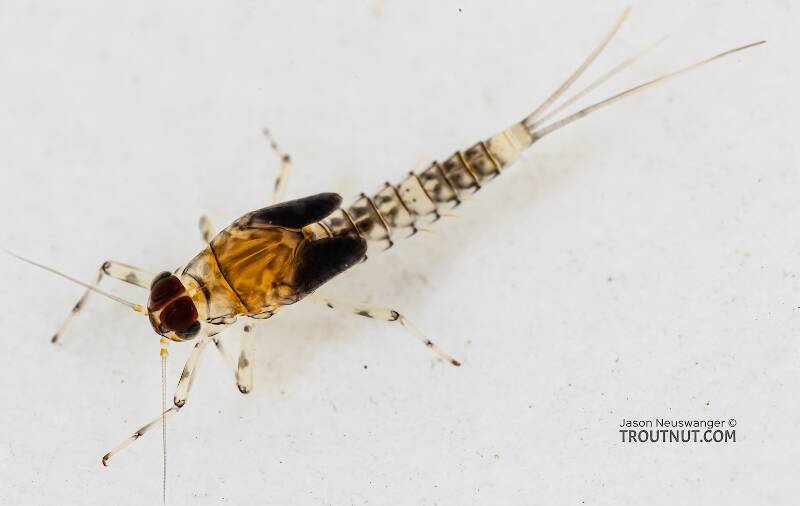
This nymph keys to Baetis assuming the villipore is present (hard to see in my photos or scope), and within that genus it tentatively keys to the flavistriga species complex, of which Baetis flavistriga itself is by far the most common in Washington state, so that's the most likely ID.
See 33 more specimens...
Mayfly Species Attenella margarita
These are very rarely called Little Blue-Winged Olives.
Though having a national distribution, this species is considered by angling authorities to be important only in the West. In localized waters where it is abundant, it can be a significant hatch.
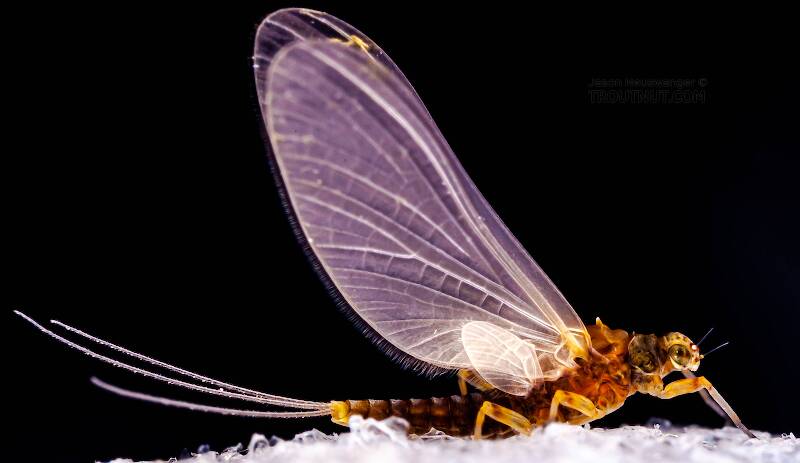
I found this dun unusually late in the year for anything in the Ephemerellidae family in the East. It's also small for that family.
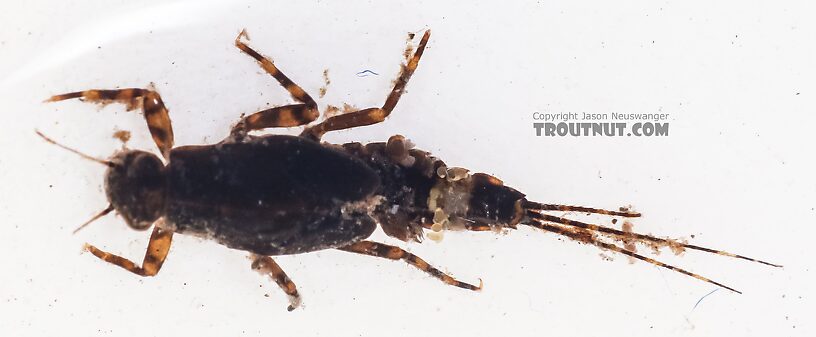
Notes from the microscope on the ID: Maxillary palp is present, distinctly 2-segmented, but very small. Gills on segment 4-7. This specimen has some unfortunate damage to the abdomen, but it's the only one I found in my sample.

